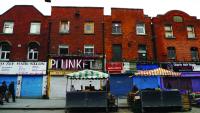Save Moore Street!
Published in 18th–19th - Century History, Issue 2(March/April 2011), News, Volume 19
Nos 17–14 Moore Street, and the plaque (inset) on No. 16, where the
decision to surrender was taken on 29 April 1916. (Patrick Cooney)
During the last days of the Easter Rising, when the GPO was in flames, the garrison hoped to escape to the Williams and Woods jam factory in Parnell Street but found themselves surrounded by British barricades. As a diversion the O’Rahilly led a sally up Moore Street, where he and his men were cut down. He died in a nearby lane, having crawled the last few yards. Meanwhile, about 300 men were able to run in groups from a side door of the GPO into Henry Place and onto Moore Lane. They broke into 10 Moore Street, and from there tunnelled along the terrace through the interior walls, setting up their last HQ at No. 16. The decision to surrender was taken here on 29 April 1916; the Easter Rising was over.
Nos 14–17 Moore Street have been designated a national monument—a gesture towards the ghosts, although they remain in private ownership. The entire terrace of fifteen houses, some of it dating back to the mid-eighteenth century, still stands but is now earmarked for development. The shells of the national monument houses will remain, but with their insides stripped, their yards built over and their fabric undermined by basement development. The planning process took years, until permission was granted in 2010; meanwhile windowpanes cracked, slates fell from the roofs, weeds grew in the gutters, and frontages became a mess of plastic fascias and boarded-up shop windows. Now the developer is in NAMA and the planned development is stalled.
Despite the heavy development of Dublin city centre through the twentieth century, this warren of streets and lanes remains much as it was then, and to tour it with a well-informed guide is a revelation. You pass the house where the Proclamation was signed. You can still see bullet-holes in walls, the doorway where a Volunteer shot the lock and killed a child within, and the window where Tom Clarke stood weeping at the loss of his hopes. Even some original cobblestones still exist, and faded business names over the doors. The site of the O’Rahilly’s death is marked by a plaque. This is by any definition a ‘battlefield site’, a living remnant of the past, but at present it is a living disgrace.
Little now remains of other Easter Rising ‘battlefields’. Liberty Hall, the Mendicity Institution, Roe’s Distillery and the Marrowbone Lane distillery are all gone, while Jacob’s, Richmond Barracks and the South Dublin Union are partly demolished, with no public access. The GPO is a replica of the original, burnt down in 1916. Boland’s Mills stand derelict. When history enthusiasts arrive in 2016, what will be left to commemorate a rebellion that resonated with independence movements all over the world? Some years ago the Irish state, quite rightly, provided €16 million to preserve the site of the Battle of the Boyne. Of course such largesse is not possible now, but the will to preserve can be more important than money—Kilmainham Jail and St Enda’s were both initially saved by volunteer labour, when the state had turned its back. For a few years now volunteers, including relatives of signatories of the Proclamation, have been providing guided tours of this area, and the Save Moore Street Committee ran tours during Dublin City Council Heritage Week in 2010.
During the recent Christmas period, the top storeys of Nos 17 and 18, to the rear of the terrace, were removed, apparently for reasons of safety. Why was there no prior consultation with any authorities, political or historical? What has happened to the removed material? Dublin City Council, reacting to this vandalism, voted on 10 January 2011 for the entire Moore Street terrace to be made a national monument. Maybe it is not too late to save it, but matters must move swiftly.
For further information, contact hq16moorest@gmail.com, or check out the Facebook site ‘Save 16 Moore Street Dublin’. You can also sign a petition at petitiononline.com/1916loz. HI
Helen Litton is a great-niece of Commdt Edward Daly, executed after the Easter Rising, and of Kathleen Daly, wife of Tom Clarke.
















